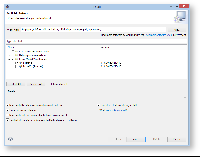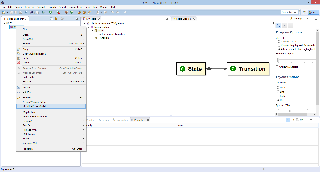...
You may want to download the slides of the presentation explaining the basic concepts you will explore in this tutorial.
| Table of Contents |
|---|
Preliminaries
...
...
...
...
...
Preliminaries
The Eclipse Modeling Framework (EMF) belongs to the most important technologies in the Eclipse world. One of the more recent indicators of this is its being used The Eclipse Modeling Framework (EMF) belongs to the most important technologies in the Eclipse world. One of the more recent indicators of this is its being used to describe the very foundation of Eclipse 4 (or e4, which of course sounds way cooler) applications: the application model. We might come back to the application model in the project phase of our practical. Another indication is that EMF has come to be the foundation of most other modeling-related Eclipse projects. Thus, there is important stuff to be learned in this tutorial!
...
| Note | ||
|---|---|---|
| ||
If you're not working with a copy of the Eclipse Modeling Tools yet, we recommend that you download the Eclipse Modeling Tools now. You might also want to check out the tutorial about Eclipse Plug-ins and Extension Points. |
Finding Documentation
For an introduction to EMF, Additionally, install the EcoreViz from the Ecore Model Visualization category from the OpenKieler update site: http://rtsys.informatik.uni-kiel.de/~kieler/updatesite/nightly-openkieler/.
Finding Documentation
For an introduction to EMF, here's a few suggestions to get you started:
- The Wikipedia article on metamodeling may be iof interest.
- The Eclipse online help system contains a section on EMF, complete with an introduction and tutorials.
- There is a book on EMF, which is a great resource. The library may have copies available. We also have at least one copy at our office, so feel free to drop in and read it. (We also have tea and a sofa, so there's no lack of proper reading atmosphere...
)
- Among many other helpful tutorials, Lars Vogel, an active Eclipse developer, has also written a tutorial on EMF.
...
- Create a new Empty EMF Project named
de.cau.cs.rtprak.login<login>.turingmodel. Remember to create the project in your Git repository if you're working with one. Once you click the Finish button, the Empty EMF Project wizard creates a new plug-in project for you, complete with asrcfolder for Java source files, theMANIFEST.MFfile we have encountered before, and, most importantly, a models folder that you will store your modeling files in. If you open the manifest file in the Plugin Manifest Editor, you will see that the wizard already added a dependency toorg.eclipse.emf.ecore, which all EMF projects depend on. - Create a new Ecore diagram Model in the models folder by right-clicking the folder and clicking clicking New -> > Other..., and then selecting Ecore Diagram from the Ecore Tools category. Note that the category Other also contains an entry Ecore Diagram. However, the editor we will be using has more features and is more user-friendly than the one in the Other category.
- In the New Ecore Diagram wizard, check Create a new model and choose
turingmachine.ecoreas the Domain file name. Once you click Finish, the wizard will generate two files for you:turingmachine.ecorecontains the information about the data structures in your Turing Machine models. In effect, it is your metamodel in Ecore format.turingmachine.ecorediagis the diagram you're editing and contains things like coordinates of the different data structures, and bend points of the relations between them – in short, everything the graphical editor needs to know to display the diagram.
- You will need the Properties view to edit your model properly. This view shows detailed information about the currently selected model element and lets you selecting Ecore Model from the Eclipse Modeling Framework category.
- In the Ecore Model Wizard name your model turingmachine.ecore. The wizard will then create a new Ecore model file for you. Open the model file and select the unnamed package in it.
- You will need the Properties view to edit your model properly. This view shows detailed information about the currently selected model element and lets you edit them. It also shows general information about the model if no specific element it selected. Summon the Properties view now by right-clicking into your diagram and selecting Show Properties View.
- Now that the Properties view is visible, switch to its Model tab and set the following properties:
- Name: Model elements are grouped into packages, and this is the package name. Set to
turingmachine. - Ns Prefix: Namespace prefix that will be used in the XML representation of your models later on. Use something short, e.g.
turing. - Ns URI: While the package name need not be unique, namespace URI's are used to uniquely identify stuff. The usual convention is to use a name following the format
http://project_name_part/packagename. Thus, set this to something likehttp://de.cau.cs.rtprak.login<login>/turingmachine.
- Name: Model elements are grouped into packages, and this is the package name. Set to
Modeling Your Turing Machines
...
- EClass – Create one for every item that you want to be in your model. Make sure that you have exactly one root element, that is, an element that represents your Turing Machine (perhaps
TuringMachinewould actually be a good name for it...) and provides access to other elements. - EAttribute – Add attributes to classes to give them properties, e.g. a
nameattribute for states in state machines. The most important property of attributes is their type, which you can configure in the Properties view. - EEnum – Create enumerations to define simple enumeration types that you can then use as the type of attributes. Each item of the enumeration is an EEnumLiteral.
- Inheritance Relations – Use these as you would in UML class diagrams or ye plain ol' Java.
- EReference – Use references to provide links between classes. Here's a few things about references:
- Every class (except the root class) requires exactly one Containment reference that specifies where it belongs to and where it will be stored later on when you save your models to XML files.
- Set lower and upper bounds on references to control how many instances of a class can be referenced (just like multiplicities in UML class diagram associations).
- Consider whether a reference should have an opposite reference: a second reference in the other direction to be able to navigate back and forth between the model objects. Let's take two classes as an example to illustrate this:
ParentandChild, whereParentcan reference multipleChildobjects. To be able to ask theParentabout all its children, we would add a referencechildrenfromParenttoChildwith the containment flag active (that is,Childis part of itsParent). To be able to ask aChildabout itsParent, we would add a second reference fromChildtoParentwith the EOpposite set to thechildrenreference.
For this task, you won't need any more model elements.
...
- the
childrenreference.
- the
For this task, you won't need any more model elements. You can add these model elements by right-clicking at a package or class and selecting New child... or New Sibling...
One last thing before you get started: While working on your model, save and validate it regularly (Edit -> Validate). This will help you find potential problems with your model while you're still able to fix them easily.
Alternative Route - Graphical Creation of a Metamodel
It is entirely possible to model your metamodel graphically. Since the graphical editing of EMF models has changed in the last Eclipse version, this is only mentioned here as alternative route. To generation an Ecore Diagram proceed as mentioned before. Now, right-click on your model file and select Initialize Ecore Diagram... from the context menu. Create a new Design -> Entities representation and select your package in the following step. You can now create and link all the model elements mentioned in the section before. The changes will be integrated in your Ecore model automatically. However, as mentioned before you don't need to edit your model graphically. This procedure is only described here for the sake of completeness.
Inspecting a Model
Nevertheless you may want to inspect your model graphically. Therefore you installed EcoreViz of the OpenKieler suite. While working on your model, you may right-click on your ecore file and select Vizualize Ecore Model. A new Klighd view will open and display your metamodel. Woha!
Code Generation
...
We won't touch upon EMF's notification mechanism in this tutorial, but we still wanted to mention it. EMF models can be (and are) used as the main models holding the data edited by applications. The notification mechanisms allow you to add observers to the model that get notified upon a definable set of editing operations executed on the model. Feel free so search the Internet for tutorials and introductions to this topic.
| Info |
|---|
This tutorial was originally created by Christoph Daniel Schulze and Miro Spönemann for the Eclipse Project WT 12/13. |

